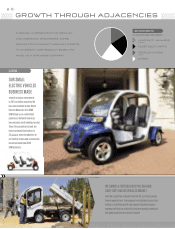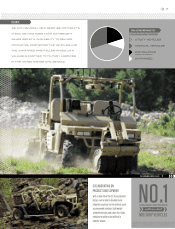Polaris 2011 Annual Report Download - page 20
Download and view the complete annual report
Please find page 20 of the 2011 Polaris annual report below. You can navigate through the pages in the report by either clicking on the pages listed below, or by using the keyword search tool below to find specific information within the annual report.Originally conceived as a utility vehicle for northern, rural environments, over time the snowmobile gained
popularity as a recreational vehicle. From the mid-1950’s through the late 1960’s, over 100 producers entered the
snowmobile market and snowmobile sales reached a peak of approximately 495,000 units in 1971. The Polaris
product survived the industry decline in which snowmobile sales fell to a low point of approximately
87,000 units in 1983 and the number of snowmobile manufacturers serving the North American market declined
to four: Yamaha, BRP, Arctic Cat and Polaris. These four manufacturers also sell snowmobiles in certain
overseas markets where the climate is conducive to snowmobile riding. We estimate that during the season ended
March 31, 2011, industry sales of snowmobiles on a worldwide basis were approximately 117,000 units, up
three percent from the previous season.
On-Road Vehicles. Polaris’ On-Road Vehicles consist of Victory®and Indian®motorcycles and Small
Electric Vehicles. Heavyweight motorcycles are utilized as a mode of transportation as well as for recreational
purposes. There are four segments: cruisers, touring, sport bikes and standard motorcycles. We entered the
motorcycle market in 1998 with an initial entry product in the cruiser segment. United States industry retail
cruiser sales more than doubled from 1996 to 2006; however the motorcycle industry declined in 2007 through
2010 due to weak overall economic conditions. We entered the touring segment in 2000. We estimate that the
1,400cc and above cruiser and touring market segments combined increased 4 percent in 2011 compared to 2010
levels with approximately 170,000 heavyweight cruiser and touring motorcycles sold in the North American
market. In 2011, we purchased the Indian Motorcycle brand to complement our Victory brand of motorcycles.
Other major cruiser and touring motorcycle manufacturers include BMW of North America, LLC (“BMW”),
Triumph, Harley Davidson, Inc., Honda, Yamaha, Kawasaki and Suzuki.
We introduced our initial SEV product, the Polaris Breeze®, in 2009, which is an electric powered vehicle
primarily used in master planned communities in the Sunbelt United States. In 2011, we ceased production of the
Breeze line of products and made two SEV acquisitions, Global Electric Motorcars LLC (“GEM”) and Goupil
Industries S.A. (“Goupil”). Both of these acquisitions add to our growing small vehicle product line. We estimate
the target market for small electric vehicles at approximately $4.0 billion in 2011, which includes master planned
communities and golf courses, light duty hauling, people movers and urban/suburban commuting. Other major
small electric vehicle manufacturers include Textron Inc.’s “E-Z-GO”, Ingersoll-Rand Plc.’s “Club Car”,
Yamaha and JH Global Services, Inc. (“StarCar”).
Products
Off-Road Vehicles. We entered the off-road vehicle market in 1985 with an ATV. We currently produce
four-wheel ATVs, which provide more stability for the rider than earlier three-wheel versions. In 2000, we
introduced our first youth ATV models. In 1998, we introduced the Polaris RANGER, a six-wheeled off-road
side-by-side utility vehicle and in 2000, we introduced a four-wheeled version of the RANGER utility vehicle. In
2004, we introduced a military version ATV and side-by-side vehicles with features specifically designed for
ultra-light tactical military applications. In 2007, we introduced our first recreational side-by-side vehicle, the
RANGER RZR®, and our first six-passenger side-by-side vehicle, the RANGER Crew®. Our standard line of
military and government vehicles for 2012 consists of 11 models at suggested United States retail prices ranging
from approximately $7,000 to $22,000. Our full line of ORVs beyond military vehicles consists of 34 models,
including two-, four- and six-wheel drive general purpose, sport and side-by-side models, with 2012 model year
suggested United States retail prices ranging from approximately $2,000 to $20,000.
Most of our ORVs feature the totally automatic Polaris variable transmission, which requires no manual
shifting, and several have a MacPherson strut front suspension, which enhances control and stability. Our “on
demand” all-wheel drive provides industry leading traction performance and ride quality due to its patented on
demand, easy shift on-the-fly design. Our ORVs have four-cycle engines and both shaft and concentric chain
drive. In 2003, we introduced the industry’s first electronic fuel injected ATV, the Sportsman®700 EFI. In 2005,
we introduced the industry’s first independent rear suspension on a sport ATV named the Outlaw®. In 2007, we
introduced the RANGER RZR, a big bore recreational side-by-side model. In 2008, we celebrated the
4
























